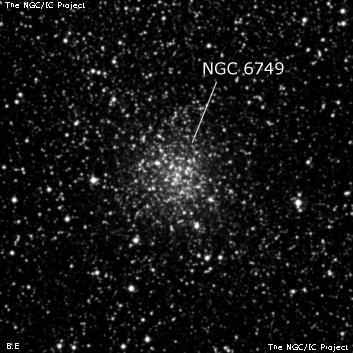
John Herschel discovered NGC 6749 = h2029 on 15 Jul 1827 (single observation) and recorded "a cluster of loose small stars of various magnitudes; fills the field." His position is 8' south-southwest of this highly reddened globular cluster. But, I'm not convinced JH was referring to the globular, which is only ~3' diameter visually and unresolved in most telescopes. The visual appearance doesn't correspond with a object that "fills the field" with "loose small stars of various magnitudes. His description seems to apply to the general Milky Way field here, which is very rich. JH catalogued a number of rich Milky Way fields that caught his eye and this may be another case.
Bigourdan examined the area on 24 August 1891 and wrote (Corwin's translation), "Extended region, slightly rich in stars, but which offers nothing remarkable. "Using Heidelberg-Königstuhl plates, Reinmuth remarked "a dense region, but no distinct cluster." Dorothy Carlson repeated "No Cl" in her 1940 paper on NGC identifications and this is referenced in the RNGC, although the classification is globular cluster. Lynga classified it an open cluster and labeled it Berkeley 42. The position given in Sky Catalogue 2000, Luginbuhl & Skiff, NGC 2000.0, Uranometria 2000, and Deep Sky Field Guide (first edition) are all wrong (for the globular), mostly off by ~7' in declination (probably from the JH and NGC position).
Harold Corwin writes, "A more appropriate scattering of stars actually overlaps the globular but extends well to the southwest...even if this is JH's intended object, I think that it is no more than a random clumping of Milky Way stars."
300/350mm - 13.1" (8/11/85): extremely faint, moderately large, very low surface brightness and fades at high power. Near the visual threshold this is one of the two faintest NGC globulars along with NGC 6380. Estimate V = 14. Located at the NW edge of an elongated group of six mag 12/13 stars and 25' ESE of mag 5.8 SAO 124203. The position listed in the NGC, SC2000, NGC 2000, U2000, and DSFG are all about 7' too far south.
400/500mm - 17.5" (7/1/00): very faint, very low surface brightness globular in a dusty portion of the Aquila Milky Way (dimmed by at least 4.5 magnitudes of extinction). The core is 15"-20" slightly brighter spot less than 1' SW of a mag 12 star. The surrounding halo is just a weak glow with averted vision, 2'-2.5' in diameter with an ill-defined edge, and just brighter than the Milky Way background. The glow encompasses the mag 12 star on its northeast side but does not reach two mag 13.5 stars off the south side. This cluster would most likely be overlooked if just quickly scanning the field and along with NGC 6380 it is one of the two most difficult NGC globulars!
17.5" (7/24/95): very faint, ~3' diameter, unusually low surface brightness for a globular cluster with only a very weak central brightening. A mag 12 star is superimposed on the north side and two mag 13.5 stars are at the south end (not members). The core appears to be located ~1' SW of the mag 12 star. Does not appear like a globular but rather a diffuse nebula in a rich Milky Way field. Difficult to determine exact outer extent.
600/800mm - 24" (7/20/12): NGC 6749 was surprisingly easy to sweep up at 200x and it was immediately noticed in the field as a fairly faint, fairly large, irregular glow, ~2.5' diameter. Still, the surface brightness is low for a globular, there was no noticeable concentration, and it somewhat blends into a rich Milky Way star field. At 325x several very faint stars were resolved, mostly around the edges. The easiest group to resolve are four or so along the north and northeast side. Another couple of stars are at the south and southeast edges. Brighter (field?) stars are off the southwest and east edges.
Notes by Steve Gottlieb